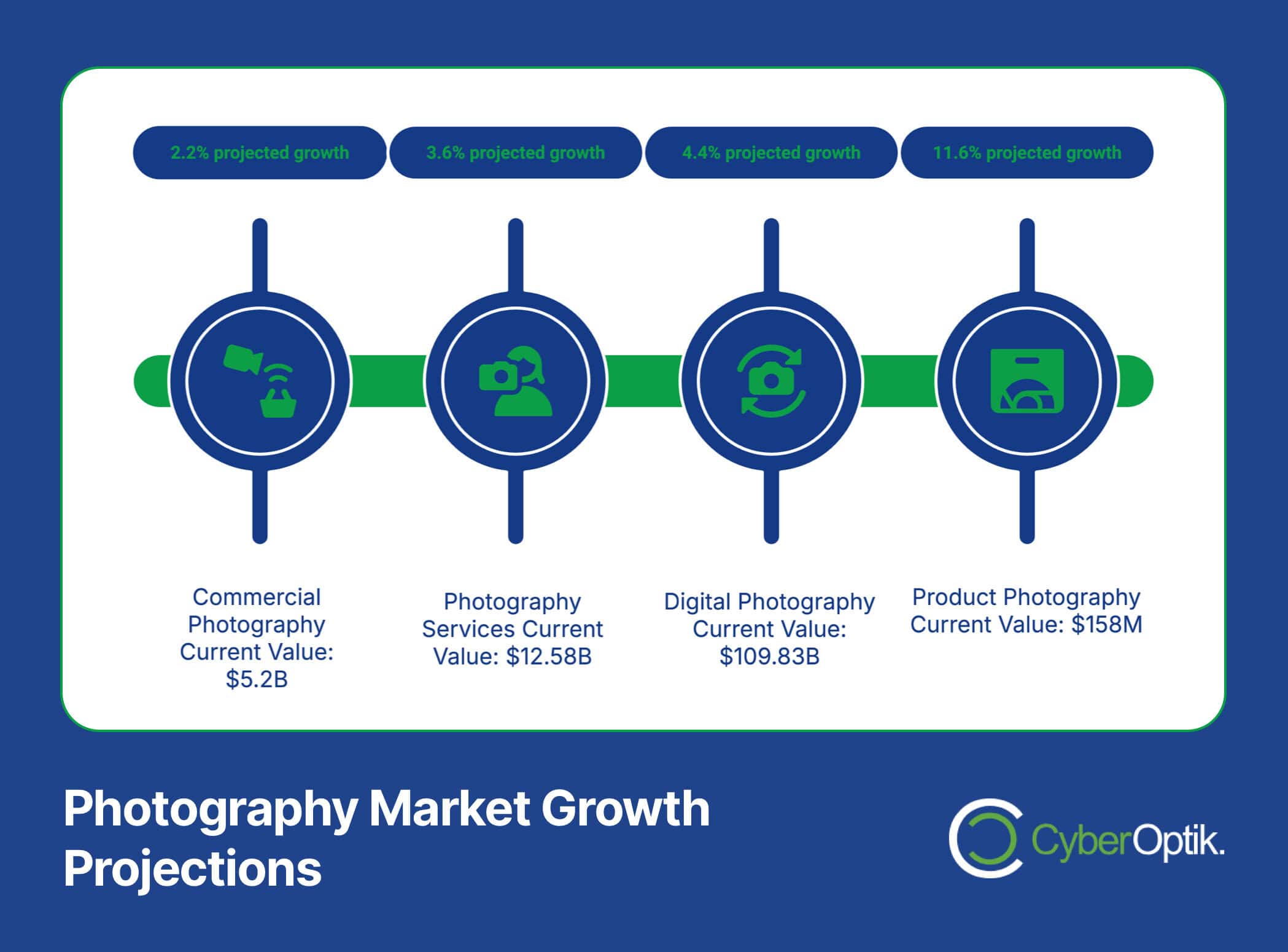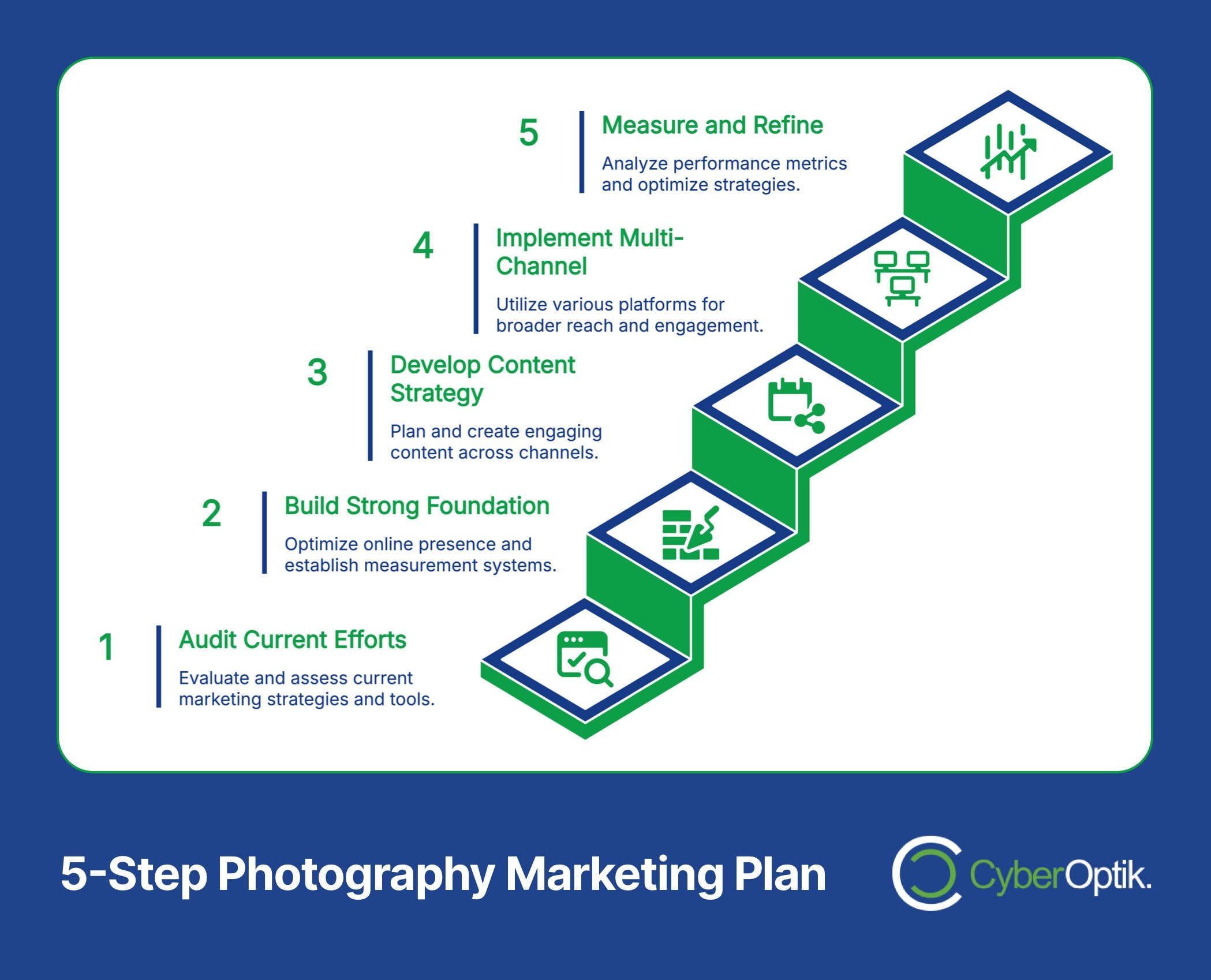Standing out in the photography industry has never been more challenging. With smartphones enabling everyone to capture decent photos, professional photographers need more than just technical skills and artistic vision. They need effective marketing strategies. The good news? We’ve helped numerous photography businesses transform their digital presence into booking machines.
In today’s competitive landscape, a strategic marketing approach makes the difference between a thriving photography business and one that struggles to find clients. The photography market continues to grow despite these challenges. Understanding how to position yourself effectively creates opportunities for substantial business growth.
In this comprehensive guide, we’ll explore proven marketing strategies specifically designed for photographers. These tactics will help you showcase your unique style, reach your ideal clients, and turn your passion into a sustainable business that generates consistent bookings.
The Current State of the Photography Industry

Before diving into specific marketing strategies, it’s important to understand the market you’re operating in. The photography industry continues to show promising growth despite increased competition. The commercial photography market is projected to reach $6.4 billion by 2032 at a 2.2% CAGR. (Source: FactMR)
This growth presents significant opportunities for photographers who position themselves strategically. Understanding market segments can help you focus your marketing efforts more effectively. Product photography dominates the commercial photography space, holding 45% of the market share in terms of revenue. (Source: FactMR)
Regional trends also show interesting patterns for photographers to consider. The U.S. commercial photography market is growing steadily at a 1.9% CAGR, largely driven by increasing e-commerce demand for professional product imagery. Meanwhile, regions like India are seeing even faster growth at a 3.1% CAGR, fueled by increasing social media marketing and advertising spend. (Source: FactMR)
The broader photography services market shows even more promising projections. Industry analysts expect this sector to grow from $12.58 billion in 2023 to $17.29 billion by 2032, representing a 3.6% CAGR. (Source: Zion Market Research)
| Photography Market Segment | Current Value | Projected Growth | Primary Growth Drivers |
|---|---|---|---|
| Commercial Photography | $5.2B (2023) | 2.2% CAGR | E-commerce demand, corporate marketing |
| Photography Services | $12.58B (2023) | 3.6% CAGR | Events, portraits, business services |
| Digital Photography | $109.83B (2023) | 4.4% CAGR | Technological advances, smartphone integration |
| Product Photography | $158M (2023) | 11.6% CAGR | Online retail expansion, visual commerce |
With this market understanding, let’s explore how photographers can capitalize on these growth trends through effective marketing strategies.
Website Optimization Strategies for Photographers
Your website serves as your digital storefront. It’s often the first substantial impression potential clients have of your work. A well-designed photography website converts visitors into clients by showcasing your best work while making it easy to contact you.
Based on our experience working with numerous photographers, we’ve identified key elements that make photography websites successful. The digital photography market value of $109.83 billion in 2023 (projected to reach $168.94 billion by 2032) shows how crucial digital presence has become for photographers. (Source: SkyQuest)
Building an Effective Photography Portfolio Website
Start with a clean design. Your website should put your images front and center without distracting elements. Choose a layout that loads quickly and displays well on all devices – especially mobile ones.
Organize your portfolio strategically. Group your work by project type, style, or client category to help visitors find relevant examples quickly. Most successful photography websites limit initial portfolio displays to 20-30 of their absolute best images.
Include these essential elements on your photography website:
- High-quality portfolio gallery with intuitive navigation and filtering options
- Clear service descriptions that outline exactly what you offer and for whom
- Pricing information (even if just starting points) to qualify potential clients
- Client testimonials that build trust and credibility
- Simple contact form that makes it easy to reach you
Your about page deserves special attention. This page builds the emotional connection that often leads to bookings. Share your photographic philosophy, experience, and personal story in a way that resonates with your ideal clients.
Photography Website SEO Fundamentals
Simply having a beautiful website isn’t enough. You need potential clients to find it. This is where search engine optimization strategies make all the difference for photographers.
Start with keyword research specific to your photography niche. Identify terms potential clients use when searching for your services. Tools like Google Keyword Planner, Ubersuggest, or SEMrush can help you discover relevant, high-opportunity keywords.
Local SEO is particularly important for photographers who serve specific geographic areas. Include location-specific keywords throughout your site, especially for wedding, event, and portrait photographers. Create location-specific service pages if you serve multiple areas.
| Photography Website Element | SEO Optimization Technique | Implementation Difficulty | Impact on Rankings |
|---|---|---|---|
| Image Files | Descriptive filenames, compressed file size, proper alt text | Easy | High |
| Portfolio Pages | Categorized galleries with unique descriptions and keywords | Medium | Medium-High |
| Blog Content | Regular posting with targeted keywords and helpful information | Medium-High | High |
| Location Pages | Area-specific content with local landmarks and terms | Medium | Very High (for local search) |
Image optimization is critical for photographers. Large, uncompressed images slow down your site significantly. Resize and compress all images before uploading them to your website. Tools like ShortPixel, Imagify, or Squoosh can automate this process.
Don’t forget to use descriptive filenames and alt text for every image. This helps search engines understand your content and improves accessibility. Instead of “IMG_1234.jpg,” use descriptive names like “chicago-wedding-photography-downtown-venue.jpg.”
Social Media Marketing Strategies for Photographers
Social media platforms provide ideal showcases for visual content. For photographers, these channels offer powerful ways to build audience, demonstrate style, and generate leads. The key lies in choosing the right platforms and implementing strategies that maximize engagement.
Not all social platforms deliver equal results for photographers. Focus your efforts where your ideal clients spend time and where your work shines brightest. Based on our experience with professional photographers, we’ve seen these platforms perform best for specific photography niches:
| Photography Niche | Primary Platform | Secondary Platform | Content Strategy Focus |
|---|---|---|---|
| Wedding Photography | Emotional storytelling, behind-the-scenes, venue features | ||
| Commercial/Product | Case studies, brand collaborations, technical expertise | ||
| Portrait/Family | Client features, session previews, seasonal promotions | ||
| Real Estate | Property highlights, area features, virtual tours |
Platform Selection and Focus
Instagram remains the powerhouse for most photographers. Its visual focus makes it perfect for showcasing your portfolio. Create a consistent posting schedule and use Instagram Stories to share behind-the-scenes content that builds personal connection.
Pinterest drives significant traffic for wedding, family, and lifestyle photographers. Unlike most social platforms, Pinterest functions more as a visual search engine where content can drive traffic months or even years after posting.
Facebook remains valuable for local photographers and those targeting specific communities. Facebook Groups particularly help wedding and family photographers connect with potential clients in specific areas.
LinkedIn works exceptionally well for commercial, corporate, and product photographers. It allows you to connect directly with business clients who need professional photography services.
Building a Visual Brand on Social Media
Consistency builds recognition. Maintain visual cohesion across all platforms through consistent editing style, color palettes, and content themes. Your social feeds should instantly communicate your unique photographic style.
Effective hashtag strategies significantly expand your reach. Social media marketing can dramatically impact photography business growth – a fact supported by research showing that businesses using social media effectively are 40% more likely to increase their revenue.
Consider these hashtag strategies for photographers:
- Use location-based tags to reach local clients (e.g., #ChicagoWeddingPhotographer)
- Include style descriptors that match your aesthetic (e.g., #MoodyPortraits, #BrightAndAiry)
- Add niche-specific tags to attract your ideal clients (e.g., #MaternityPhotography, #CorporateHeadshots)
- Research trending hashtags in your specific photography genre
- Create a branded hashtag for your photography business
Engagement matters as much as posting. Respond to comments, engage with potential clients, and build community through meaningful interactions. The most successful photographers on social media spend as much time engaging with others as they do creating their own content.

Email Marketing for Photographers
While social media gets more attention, email marketing often delivers higher conversion rates for photographers. Email provides direct communication with people who have already expressed interest in your services. This makes it one of the most effective channels for booking clients and generating repeat business.
The photo market is expected to reach $9.2 billion globally by 2032, growing at a 6.7% CAGR – making it essential for photographers to use direct marketing channels like email to capture their share. (Source: PR Newswire)
Building and Growing Your Email List
Start with strategic lead magnets. Offer something valuable in exchange for email addresses. For photographers, effective lead magnets include:
- Session preparation guides (what to wear, how to prepare)
- Location guides (best spots for photos in your area)
- Mini-session announcements with early access
- Seasonal photography tips (holiday card photos, summer vacation shots)
- Exclusive discount on first booking
Place sign-up forms strategically throughout your website. The footer, contact page, and blog posts work well. Consider a pop-up for first-time visitors offering your lead magnet, but ensure it doesn’t disrupt the user experience on mobile devices.
Segment your list for better results. Divide subscribers based on interests, services they’ve inquired about, or past client status. This allows you to send more relevant content that drives higher engagement and conversion rates.
Effective Email Campaign Ideas for Photographers
Welcome sequences introduce new subscribers to your brand. Create a 3-5 email sequence that introduces your work, shares your story, and provides valuable content before making any offers.
Seasonal campaigns align with natural booking cycles. Plan email campaigns around key seasons for your photography niche – engagement season for wedding photographers, fall for family photographers, or product launch cycles for commercial photographers.
| Email Campaign Type | Content Elements | Ideal Frequency | Expected Results |
|---|---|---|---|
| Welcome Sequence | Introduction, portfolio highlights, client stories, FAQ | 3-5 emails over 2 weeks | Brand familiarity, inquiry generation |
| Portfolio Updates | Recent work highlights, behind-the-scenes, creative process | Monthly or quarterly | Style awareness, passive engagement |
| Special Offers | Limited-time promotions, mini-sessions, referral incentives | 3-4 times per year | Direct bookings, revenue spikes |
| Client Nurturing | Anniversary reminders, lifecycle suggestions, personal updates | Triggered by dates | Repeat bookings, referrals |
Client nurturing emails maintain relationships after sessions. Send anniversary emails to wedding clients suggesting anniversary sessions. Remind family portrait clients when it’s time for updated photos. These timely reminders often result in repeat bookings.
Keep design clean and focused on your images. Use mobile-responsive email templates that showcase your photography beautifully. Most email marketing platforms offer photographer-specific templates that you can customize to match your brand.
Advanced Marketing Techniques for Photographers
Once you’ve established your core marketing foundations, these advanced techniques can help you stand out in an increasingly competitive market. Implementing specialized strategies creates additional booking opportunities and helps differentiate your business.
Technological innovation continues to create new marketing opportunities. The increasing popularity of immersive visual content provides photographers with powerful ways to showcase their work and capabilities.
Paid Advertising Strategies
Strategic Facebook and Instagram ads deliver exceptional results for photographers when properly targeted. The visual nature of these platforms aligns perfectly with photography services. Create campaigns targeting specific demographics, interests, and behaviors that match your ideal clients.
Google Ads help you appear exactly when potential clients are searching for photography services. Focus on local service ads and targeted search campaigns using location-specific keywords like “wedding photographer in [city]” or “family portrait photographer near me.”
Remarketing campaigns help convert website visitors who didn’t immediately book. These campaigns show your ads to people who previously viewed your website as they browse other sites or social media. This repeated exposure significantly increases conversion rates.
Leveraging New Technology in Photography Marketing
360-degree photos create immersive experiences that standard images can’t match. Pages featuring 360-degree photos retain visitors for 18% longer than those with traditional images. (Source: Great Big Photography World)
Drone photography opens new market opportunities, especially for real estate, landscape, and event photographers. The drone photography market is forecasted to hit $28 billion by 2032, driven primarily by real estate and environmental applications. (Source: Great Big Photography World)
Virtual galleries and online exhibitions extend your reach beyond physical limitations. Creating virtual experiences allows potential clients to engage with your work in a more immersive way than traditional portfolio websites. This approach works particularly well for fine art and commercial photographers.
AI and automation tools streamline your marketing efforts. The generative AI market is projected to grow at 42% CAGR, reaching $1.3 trillion by 2032, offering photographers new tools for content creation, client communication, and workflow automation. (Source: Great Big Photography World)
Building Strategic Partnerships and Networking
Collaborations often generate more bookings than solo marketing efforts. Identifying and building relationships with complementary businesses creates powerful referral networks that benefit all parties involved. The global photography services market is projected to reach $60.8 billion by 2032, creating abundant partnership opportunities within and beyond the industry. (Source: GlobeNewswire)
Start by identifying businesses that serve your same client base but don’t compete directly. For wedding photographers, this includes venues, planners, florists, caterers, and dress shops. For commercial photographers, consider design agencies, marketing firms, product developers, and e-commerce businesses.
Create mutual benefit in your partnerships. Offer to provide complimentary images that partners can use in their marketing in exchange for referrals. Develop special packages exclusively for their clients. Share their content on your social channels and feature them on your blog.
Collaborative content marketing delivers exceptional results. How do you create compelling blog content that showcases these partnerships? Create guest posts for partner blogs, develop joint style shoots, or create resource guides that feature multiple vendors.
In-person networking remains valuable despite digital marketing’s prominence. Join professional photography associations like Professional Photographers of America (PPA) or American Society of Media Photographers (ASMP). Attend industry events, creative meetups, and local business gatherings to build relationships that lead to referrals.
Measuring and Optimizing Your Photography Marketing
Effective marketing requires measurement. Without tracking key metrics, you can’t determine which strategies deliver results and which need adjustment. Setting up proper tracking systems helps optimize your marketing budget and efforts.
Understanding marketing performance across channels helps photographers make data-driven decisions. The photography services market is expected to reach $20.9 billion by 2028 with a 3.7% CAGR – making measurement essential to capture market share efficiently. (Source: Market Research Future)
| Marketing Channel | Key Performance Indicators | Measurement Tools | Optimization Actions |
|---|---|---|---|
| Website | Visitor sessions, time on site, inquiry form submissions, bounce rate | Google Analytics, website form tracking | Improve page load speed, enhance portfolio layout, simplify contact forms |
| Email Marketing | Open rate, click-through rate, booking conversion rate | Email platform analytics (Mailchimp, Flodesk, etc.) | Test subject lines, improve image-to-text ratio, segment lists |
| Social Media | Engagement rate, follower growth, direct message inquiries, click-throughs | Platform insights, Hootsuite, Later | Adjust posting times, refine content types, improve hashtag strategy |
| Paid Advertising | Cost per lead, conversion rate, ROAS (Return on Ad Spend) | Facebook Ads Manager, Google Ads dashboard | Refine targeting, improve ad creative, adjust bidding strategy |
Start by tracking these essential metrics for photographers: website traffic sources, inquiry-to-booking conversion rates, client acquisition cost, and revenue by service type. These core metrics provide the foundation for understanding your marketing performance.
Set up proper attribution tracking to understand which channels drive bookings. Use Google Analytics along with simple intake questions asking new clients how they found you. For more advanced tracking, implement UTM parameters on your marketing links.
Create a simple monthly dashboard to monitor trends. Include key metrics like website visitors, social media engagement, email list growth, inquiry numbers, and booked sessions. Compare these figures month-over-month and year-over-year to identify patterns.
Calculate return on investment for each marketing channel. Divide the revenue generated by the cost (including your time) to determine which efforts deliver the best returns. This analysis often reveals surprising insights about which marketing activities deserve more of your resources.
Many photographers discover through measurement that email marketing and strategic partnerships frequently yield the highest ROI, while social media platforms require constant attention for consistent results.
Conclusion: Creating Your Photography Marketing Plan
Effective marketing for photographers requires a strategic approach across multiple channels. By implementing the strategies outlined in this guide, you can increase your visibility, attract ideal clients, and build a thriving photography business.
Start by auditing your current marketing efforts against the strategies discussed. Identify gaps and opportunities in your website optimization, social media presence, email marketing, and strategic partnerships. Begin with the tactics that address your most significant weaknesses.
Create a content calendar that engages your ideal audience and supports your business goals. Plan content across channels that showcases your best work while providing value to potential clients.
Remember that consistency matters more than perfection. Implement manageable marketing activities that you can sustain long-term rather than attempting everything at once. Even modest marketing efforts, when applied consistently, yield significant results over time.
We’ve helped numerous photographers transform their online presence and marketing strategies to generate consistent bookings. If you need assistance implementing these strategies or want to take your photography marketing to the next level, reach out to our team at CyberOptik for a personalized consultation.
Ready to transform your photography business with effective digital marketing? Start by implementing one strategy from each section of this guide, measuring the results, and building from there. Your next client is searching for you – make sure they can find you.




